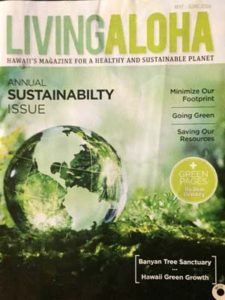By Denise LaBarre
We all want to live in a sustainable world. But how do we take the steps to get there? As I thought about replacing my old gas-engine car with an electric car that I recharge with rooftop photovoltaic energy,[1] I realized there are plenty of ways I can reduce my consumption footprint, and take steps toward a more sustainable world – immediately. I bet you already do some conscious things to care for the planet so here are more ways to reduce your consumption footprint, now.
- Watch your consumption patterns – Becoming more conscious about your buying and use of stuff is one of the most important things you can do to “go green.” It can be daunting when you really look at how much you use to support your lifestyle, but change happens if you choose it.
Ask yourself: “What can I do to stop wasting food, water, plastic products, other things?” Ask: “Are people, animals, or the planet exploited in the production of what I consume?” We are coming to see how deeply we are all connected and that even small choices can have large cumulative consequences – either negative or positive. As you look for sustainable options and support conscious businesses you shift how business happens.

Talk to suppliers and manufacturers
2. Tell your suppliers – talk to owners and managers of restaurants you frequent and ask them to supply “green” take-out containers and to source local products. Tell business owners that you purchase with sustainability in mind. Put your money where your heart is.
As we demand more conscious consumer options , they will appear. At a restaurant the other day I wanted a little piece of foil and a small cardboard box to put my leftovers in. The server handed me a stack of large Styrofoam boxes. I took one box (so as not to waste the food) and on my way out told the manager that the restaurant was much more likely to get my repeat trade if they used smaller “green” cardboard containers instead of large, wasteful Styrofoam. As I felt good about speaking up, I thought of several other ways I could become more aware of my consumption footprint and help shift awareness in others. I now carry a reusable container in my car for situations like that.
Shop with an eye toward less packaging
3. Buy products with less packaging – When you have a choice, buy the thing with less bubble-packaging or cardboard instead of anything Styrofoam.
There are so many small things you can do that add up in a big way if everyone does them. Take bottled drinks… US consumers use 30 billion plastic drink bottles per year. You can switch away from buying drinks in single-use containers. Providing water or juice in plastic bottles to a team after a game may seem more convenient, but don’t you want to teach those kids sustainable habits and hand them a clean, conscious world they can live in? Kids can carry their own water bottles that they fill from a large, reusable “team” container.
4. Enlarge your perspective. There is really no such thing as “toss and go.” Go where? We don’t have another planet to move to and our trash doesn’t just go away.
It may seem easier to use and throw away now but in the long run, it will be more difficult to watch our children deal with the legacy of our indifference. Paying more in the short term will shift the norm to sustainable, “green” options, which will then become less expensive through economies of scale.
We can shift our collective priority from maximum-benefit-for-me to maximum benefit-for-all!
You know you’re supposed to recycle, but it takes extra time and work to prepare your recyclables and haul them to the recycle centers. If you consume something, you’re also responsible for the waste it produces. Keep in mind that the energy and resources it takes to collect, transport, sort, melt or mash, and remake the materials into something else is still huge – often more than it took to produce the original thing. It’s better to buy consciously, then clean and store your containers to reuse them yourself.
5. Pick up trash as a “gateway” habit 😉 Start taking responsibility for your planet one piece of litter at a time and let that be your gateway into doing more. Better yet, take a kid with you as you walk and pick up trash.
Carry a spork! Get away from single-use plastic, start with utensils
Another easily-fixable problem in our culture is one-time-use plastic – cups, straws, knives, forks, spoons, styrofoam take-out containers…. When we travel, we might use 3-6 plastic forks in a day, several styro cups and plastic food containers… throwing out each one after a meal. You may already carry a glass or stainless drink bottle so how about carrying a spork as well? A spork is a fork and spoon combined into one reusable utensil and handy to carry in the pocket or purse.

I found a cool stainless steel spork that’s way better than bamboo sporks – which eventually get moldy. This one has sharp tines + a deep bowl that is great for soup; it’s easy to clean and looks cool. It makes a great consciousness-raising gift for friends who will bother to carry and use it. Google: Norpro spork.
It takes a little extra time to clean my spork and some extra time to take my boxes, plastic, and glass to the recycling center. But it’s time invested in healing my over-consumptive footprint on the planet.
Also, carry reusable mesh vegetable bags with you to the grocery store or farmer’s market so you don’t take plastic ones. Reusing plastic bags is good. Not taking them in the first place is even better.
We want to create a sustainable world
6. Take baby steps – The best way to shift habits is by taking small steps, consistently over time and build on them consciously. It took billions of auto trips adding carbon monoxide to our air; billions of tossed-away plastic pens, bags and utensils to create the huge trash gyres in our oceans; and it will take billions of conscious decisions to reduce, reuse and recycle to heal the damage we’ve done. But we can do it! Just as our fingers heal from a cut, the earth can heal from the damage we’ve caused.
Water consumption is key
7. Be conscious about Water – In the tropics where it rains a lot and on an island surrounded by ocean, it’s easy to take water for granted. But we can’t afford to waste this precious resource. Flush the toilet as minimally as possible. (Growing up with water rationing in California showed me how “normal” this can become.) Don’t let the water run when you brush your teeth. See how many ways you can reduce your water waste and use water consciously.
8. Make Sustainable “cool” – Currently, Western culture and its media portray wasteful as cool. “Cheap and convenient” has been the consumer’s bottom line. In your social media, post memes and videos that promote conscious consumption and ways to conserve. Add comments that question mindless consumerism and waste. Make it more cool to sweep your driveway with a broom than use an electric blower or a hose.
9. Keep going! When you start using a spork (or whatever your next steps are) set your intention to build upon each one. It’s a complicated world and if we wait until conditions are ideal to act, we will never act. Do what you can, with as much integrity as possible, now. It may not be perfect, but it’s movement in the right direction. The planet, and all those aboard, and future generations thank you.
[1] Watch the 2006 film, Who killed the Electric Car?
* This article originally appeared in the May/June 2016 issue of Living Aloha Magazine
** This article first appeared in Living Aloha Magazine, May/June 2016. www.livingaloha.net
#sustainableworld #sustainability #consumptionpattern


